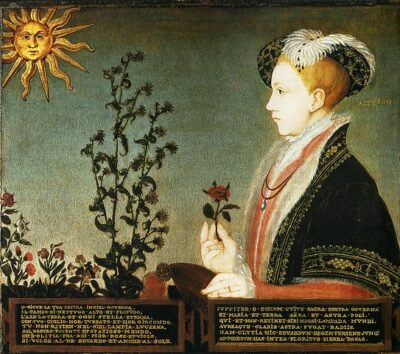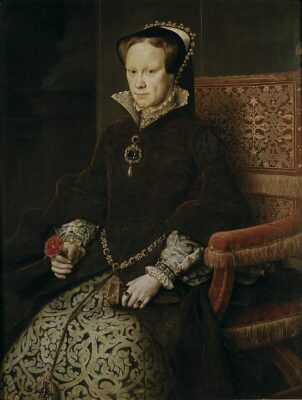I’ve been stuck for nearly a week over a chapter in the WIP. (The whip, I think ruefully, as I type those letters.) The problem has many causes. One is that I have a stubborn need to know where-the-heck my heroine (Elizabeth Tudor, in this instance) is, in fact. It’s a period of only two days, and historians don’t provide the details—which should lead me to suspect that the information simply isn’t available.
It’s an important moment, so I’m surprised not more is known. Fifteen-year-old King Eddie VI has died, and (after something of a bloodless battle) his half-sister Mary has been proclaimed queen.
Mary’s much younger half-sister Elizabeth (not yet twenty), is now the heir to the throne. She is riding out to meet Mary—to bow before her sister queen.
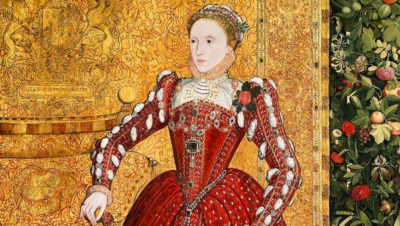
Elizabeth, a good ten years later.
First, the frazzled timeline
This is what is said:
On Friday, July 28, 1553, news of her sister Mary’s accession reaches Elizabeth at Hatfield. (Tudors—Twenty-eight Days to Wanstead by Alan Cornish)
This website account is fantastic, but this one date is unlikely, in my view, because Mary was proclaimed queen in London on July 19.
According to historian Tracy Borman in Elizabeth’s Women (page 136), Elizabeth wrote Mary on that day to congratulate her, but also …
Showing all due deference, she also humbly craved Mary’s advice as to whether she ought to appear in mourning clothes out of respect for their brother, Edward, or something more festive.
(This is the type of detail I relish.)
It would have taken time for Elizabeth’s missive to reach Mary, for she was in the northeast, at her Framlingham castle, already attending to matters of state business and debating whether or not to go to London. Some advised her that it would be wise to return soon while the public was so enthusiastic about her. On the negative side, it was stinking hot in London and there were rumours of plague.
Mary was apparently prepared to be magnanimous in her triumph. She therefore invited Elizabeth to accompany her to London. (Borman’s Elizabeth’s Women)
Mary set out for London on Monday, July 24. It was a long journey: Ipswich (two nights), Colchester (one night), Newhall (three nights), Ingatestone (two nights), Havering (one night), finally arriving at Wanstead House on Tuesday, August 1, where she welcomed Elisabeth the next day, on August 2. (This overnight stay is rarely mentioned in biographies.) Together they set out for London on Thursday, August 3—with a combined entourage of over twenty thousand—arriving late that afternoon in London.
Elizabeth set out to meet Mary on Saturday, July 29, and by most accounts, she stayed for only one night in London before heading out the next day, Sunday, July 30, to meet Mary.
The puzzle
The journey from the London gate to Wanstead takes but a few hours on foot. (See my note below.) If Elizabeth was in London on July 29 for only one night, and met Mary on August 2 near Wanstead, where was she on July 31 and August 1? She was travelling with an entourage of over a thousand, so it was not as if she could drop in just anywhere.
This question foolishly cost me several days of work. I finally found support for the likelihood that Elizabeth had simply stayed at Somerset House, her new (to her) manor in London, for the full three nights. (Elizabeth I; The Word of a Prince, by Maria Perry, page 83.)
Second, the frazzled meet-up
A few historians state that Elizabeth stayed with Mary for one night at Wanstead House, and the consensus seems to be that they met on the road, and that Elizabeth dismounted and knelt in the dirt before Mary.
The problem with writing fact-based fiction — at least for me — is that things have to make sense. So now my question was: If Mary was expecting Elizabeth at Wanstead House, why did she meet her on the road? I didn’t want to spend another week on this, so I decided to sketch out a draft where they meet on the road, Elizabeth kneels, and they move on to Wanstead House from there.
But then what?
However Elizabeth and Mary meet, the sheer size of their entourages boggled my mind. Elizabeth had an entourage of over a thousand, but it was nothing to compare with her sister’s following. Imagine:
In the late afternoon of 3 August, Mary Tudor set out in procession from Wanstead to take possession of her kingdom. Those who stood along the processional route to London were astounded by the great number in her party. Mary had an escort of some ten thousand people with her – ‘gentlemen, squires, knights and lords’, and not to mention, the various peeresses, clergymen, judges, heralds, and foreign dignitaries come to pay her tribute.
—The Turbulent Crown: The Story of the Tudor Queens by Roland Hui (p. 322).
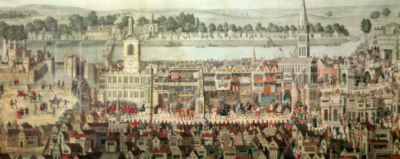
This is an image of the coronation procession of Elizabeth’s brother, King Edward VI. Imagine the traffic congestion!
This was at a hot time of year: the dust clouds of Mary’s procession coming through rural Essex must have been horrendous.
It did not take long to run into another time-consuming research question: Once they reach London, followed by well over ten thousand, what route do they take to the Tower of London? I decided that one hint might be to find out what the traditional route for a regal procession to or from the Tower of London might have been. This (eventually) led me to an amazing book (in four volumes): The Progresses and Public Processions of Queen Elizabeth by John Nichols on https://books.google.ca. On page 115 of Volume 1, there is this map:
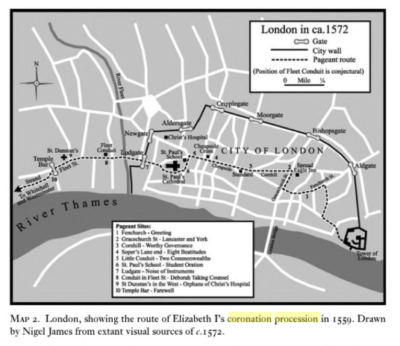
Knowing this, I was able to chart the route on the fabulous interactive Agas Map of Early Modern London: Entering at Aldgate, they would wend their way down Aldgate Street, take the left fork onto Fenchurch Street, left onto Mark Lane, right on Tower Street and right again on Petty Wales to the entry into the Tower.
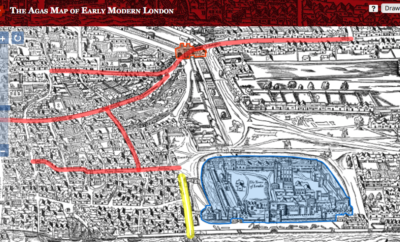
To the Tower!
My second puzzle, also solved today, was to determine where were the queen’s apartments in the Tower of London. Several maps later, including the one below, I discovered that the queen’s apartments were in the lower right-hand corner of the Tower premises, fairly cut off from any unpleasantness.
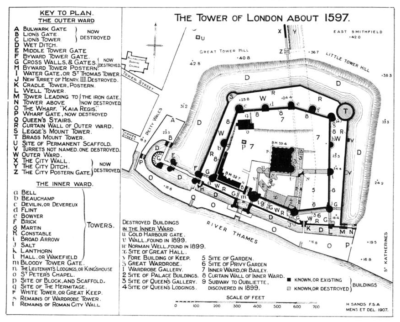
For what queen’s apartments might have looked like, I found an excellent blog post on The Tudor Travel Guide: The Royal Apartments at the Tower & the Scandalous Killing of Anne Boleyn.
In addition to great details, the site provides this image of what the Great Hall at the Tower likely looked like:
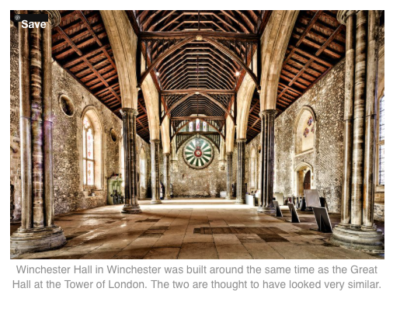
This helps give me a feeling for what the rooms beyond might have been like.
How much of this is likely to end up mentioned in the novel? Likely very little, but knowing what’s what helps me imagine the scenes.
Confession: two research tricks
To estimate approximate walking distances, I find it useful to use maps.google.com.
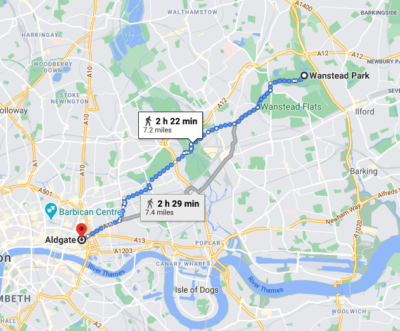
(Too bad maps.google doesn’t have an “on horseback” option. For this, I suspect that somewhere between “walking” and “by bike” might be an approximation, given all the stops horseback travel requires to give the horses rest, food, and water, or possible exchanges.)
Another part of knowing what’s what is determining when the sun rises and sets, and (particularly in this time) when the moon is full. I can’t track that for 16th century England, so instead, to at least keep the sun and moon on realistic trajectories I’m using the current calendar for the UK using this fantastic site: timeanddate.com.
And so? So now “all” I have to do is write the #%&@ scenes.
Resources mentioned
Elizabeth’s Women by Tracy Borman.
Elizabeth I; The Word of a Prince, by Maria Perry.
The Agas Map of Early Modern London
The Progresses and Public Processions of Queen Elizabeth by John Nichols.
The Royal Apartments at the Tower & the Scandalous Killing of Anne Boleyn, a blog post on The Tudor Travel Guide.
The Turbulent Crown: The Story of the Tudor Queens, by Roland Hui.
Tudors — Twenty-eight Days to Wanstead by Alan Cornish. This website post is a wonderfully detailed account.


